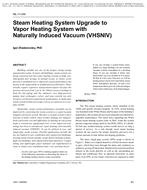Description
Building retrofits are one of the largest energy-saving opportunities today. In many old buildings, steam systems are being converted into hot-water heating systems at high cost. Anticipated fuel savings of around twenty to twenty seven percent is attributed not to improved system performance but mostly to the replacement or modification of old boilers. These retrofits require expensive replacements/repairs because the pressure increase from 2 psi to 30–100 psi causes a leakage in both the old piping and the radiators; new high-pressure pumps, heat exchangers, valves, and zone controls not only increase cost but also require more maintenance. A single-pipe steam system retrofit on average is twice as expensive as a twopipe retrofit.
Meanwhile, steam system performance normally can be improved by converting the steam system to a vapor/vacuum (negative pressure) system. Because a vacuum system is more tolerant of leaks (which cause neither damage nor danger), both conversion cost and difficulties of running an old system under a vacuum are significantly less. A new improved technology has been re-introduced: vapor heating with naturally induced vacuum (VHSNIV). It can be utilized in two- and single-pipe steam systems. Possible applications include but are not limited to new residential and commercial buildings, existing steam system retrofits, steam district heating systems, high-rise buildings, and cogeneration heat and power. Copper tubing and lightweight panel radiators are implemented in order to reduce new installation time, cost, and heat losses.
Citation: ASHRAE Transactions, Volume 117, Part 2, Montreal, QC
Product Details
- Published:
- 2011
- Number of Pages:
- 10
- File Size:
- 1 file , 3.7 MB
- Product Code(s):
- D-ML-11-030




